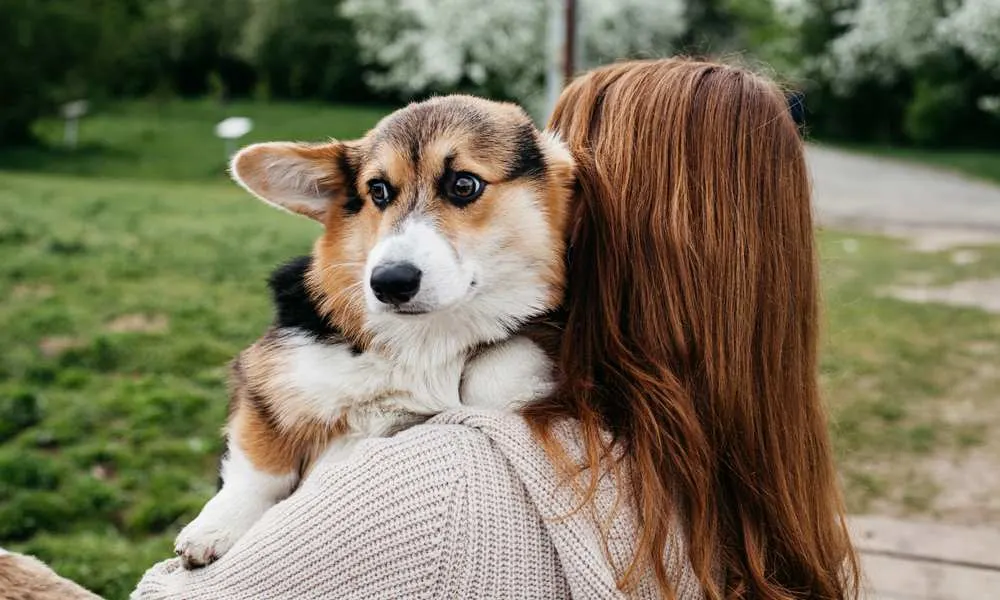As you’ve probably already noticed, corgis are a must-have dog breed these days. Naturally, the demand for new corgi puppies is higher than ever before.
Consequently, many inexperienced breeders are breeding their corgis too often despite health risks. Add to this the lack of knowledge and the need to please the general public, and the results are usually unhealthy and poor quality corgi pups.
A responsible breeder should always strive to improve the breed as a whole, not just increase its numbers. Therefore, the quality always comes before quantity.
When done right, breeding can improve your dog’s overall health and growth. However, if done ill-advised, it could bring several health problems and jeopardize your dog’s life.
So, what is the best time to breed your female dog? Should you do back-to-back breeding through heat cycles, or should you wait in between heats?
How often can corgis have puppies?
In today’s article, we’ll share some vital information regarding corgi breeding, so continue scrolling!

Knowledge Before Breeding
If you want your dog and its litter to stay healthy, you first need to know some basics before you start breeding.
Bringing your pooch to regular vet checks and ensuring it has good exercise and diet routines is the first important thing you should keep in mind.
As long as the dogs are fit and healthy, they should be good candidates for breeding.
Of course, the litter’s quality will depend on both males’ and females’ set of genes. Therefore, finding the right stud for your bitch is essential.
Anyways, deciding what’s the right time to breed your dog will depend on multiple different factors such as dog’s breed, size, sex, and health.

Sexual Maturity In Dogs
Sexual maturity or puberty typically occurs around six months of age.
However, every dog breed is different. It can take up to 2 years for larger female breeds to come into heat, while smaller breeds usually experience it as early as 4 to 6 months of age.
As for corgis, males’ puberty occurs around 6-8 months of age.
Female corgis tend to be slightly older when the first heat cycle occurs, around 9 to 11 months old. Bitches have two heat periods per year, which are six months apart.
Every heat cycle lasts around 2 to 3 weeks, and they can become pregnant during each.
In order to make sure that breeding is taking place at the right time, the vets will usually do blood and progesterone tests and/or vaginal smears.

When Is The Right Time To Breed Your Corgi?
Many experts would agree that the best time to breed your female dog is when she fully develops.
What does that mean in particular?
Well, just because your dog has experienced her first heat cycle doesn’t mean she’s ready to have a litter.
It is advisable to wait until her second or third heat cycle before you breed her and consult the vet before taking that step.
Here are some of the reasons why you should wait until her third heat cycle:
- A dog that hasn’t fully grown into its adult size may have health problems upon reaching maturity.
- The dog needs to reach adulthood to be tested for various medical conditions, which is essential before considering breeding your furry pal.
- If the female is too young, it is highly likely she won’t be able to take care of her newborns, which means more responsibility for you and possible behavior problems with the puppies.

What About Male Dogs?
Male corgis reach their sexual maturity at an earlier age, but that still doesn’t mean they are ready to mate, even if they respond to females around them.
That’s simply because the optimal quality of the sperm is reached after the stud fully develops.
That again depends on the size and the breed, but let’s say it’s not recommended before he’s at least one year old.
Also, older or unhealthy dogs shouldn’t be used for breeding. As we’ve already mentioned, a responsible breeder should strive to improve a breed as a whole. The main goal should be to produce healthier and better puppies not prone to health issues.

How Often Can A Dog Produce A Litter?
This topic is up for debate. Some breeders will breed their dogs every heat season, while others will wait in between two heats.
Technically, a healthy adult dog should be able to mate and have a litter with every heat cycle.
However, opinions vary when it comes to back-to-back breeding.
Some believe that breeding your female dog every heat cycle might decrease her ability to bear healthy puppies over time.
On the other hand, there are breeders that prefer to breed their female dog the first 2 to 3 heat cycles and then spay and retire her. That’s because many of them believe that there’s no real evidence that waiting between two heat cycles will help the dog rest and recover.
What’s more, some may even say that waiting between isn’t recommended because with every missed heat cycle, a dog’s uterus ages. The theory behind this is that the older she gets, the less able she is to bear healthy puppies.
We also found research that claims how not breeding a female dog when it comes into heat might be, in fact, bad for its health. To make matters worse, some scientists say how skipping a heat cycle may lead to false pregnancy, which may increase the dog’s risk for mammary cancer.
Nevertheless, every breed and every dog is a unique case. Hence, you should always talk to your veterinarian before you make any rash decisions.

How Often Can You Breed A Female Corgi?
Gestation in dogs is very different than the one in humans. Corgi pregnancy lasts around 63 days, which is approximately a little over two months. The nursing period varies between 3 to 4 weeks.
Like humans, dogs also have trimesters, and each is 21 days long. During this short period, your dog will undergo many changes, such as prominent nipples and breasts.
At the beginning of the third trimester, your vet will be able to see how many puppies your corgi’s carrying by doing an ultrasound.
The breeding process itself isn’t the main problem.
In the end, the pregnancy (gestation) and the nursing (whelping) period are the main two reasons for waiting between pregnancies as each takes a lot of energy from female dogs.
After each whelping, females need time in order for their uterus to regrow parts and their decreased muscle tone to recover. Some bitches also lose their fur during this time.
In addition, nursing exhausts the female dog and doesn’t make the recovery process easier but harder instead.
Having said that, even though there’s a debate about how long a breeder should wait between pregnancies, it is best to let your dog fully recover.
A general safe frequency of breeding amongst reputable and ethical breeders is around 18 months to 2 years if you want to cut the risks of damaging your dog’s health.
Remember that responsible breeding is not about how many litters can your female corgi produce. You shouldn’t think about the numbers or the profit when entering this field of ‘business.’
Your dog’s health and the health and quality of its litter should be the most important thing to you. The money you earn from puppies should always go back into your dogs. That’s the whole point.

How Many Times Can A Female Corgi Be Bred?
The number of litters a bitch can carry during her lifetime will depend on her overall health, size of the litter, and how well she recovers after every pregnancy and whelping.
Moreover, the number of matings will vary on the amount of recovery time she requires and her heath cycles.
It is said that the optimal number of litters for a female dog is between 3 or 4.
Even though a dog could easily whelp more than four litters, it is highly recommended that you don’t exceed this number.
This is because frequent breedings and large litters can significantly influence her health and may even shorten her life.

How Many Times Should A Male Dog Be Bred?
In terms of breeding a male dog, the story is quite different than with females.
Male dogs can indeed be bred an unlimited number of times in their lifetime.
Albeit the case, it’s really up to the owner of the stud to decide how many times the breeding will occur.
There are two important factors that are imperative when breeding a male dog:
- The dog should be a fully grown adult
- The dog has to be healthy and fit
Unlike female dogs whose uterus ages, male dogs can produce high-quality dog sperm throughout their entire life.
In order to start breeding your male corgi, you will need to make regular vet visits and do overall health and sperm/fertility check.
Now that we got this clear, it’s time to answer the following: how often can you breed your male dog?
Although some people will have no problem breeding their male dog several times in one day, it is not advisable.
The amount of time between two ejaculations is very important in order to achieve good results. That’s the reason why veterinarians advise breeders to breed their dogs once a day for three days in a row or every second day.
Breeding your stud more than once in one day or more than five days in a row may cause your dog to run out of sperm or significantly reduce it. That can lead to no impregnation, small litter, or may just tire out your dog.

Health Concerns When Breeding Corgis
The average life of both Pembroke and Cardigan Welsh corgis is between 11-13 years old. Corgis are generally a healthy breed, but several health conditions may affect them during their lifetime.
The most common disease, according to statistics, is degenerative myelopathy and Von Willebrand’s Disease.
Other medical conditions that affect corgis are:
- Dystocia
- Stalled Labor
- Eye conditions
- Hip Dysplasia
- Intervertebral Disk Disease
- Epilepsy
The Risk Of C-Sections
The number of reported c-sections in both Pembroke and Cardigan Welsh corgi has become relatively high.
The rate of c-sections in Pembroke corgis is 37% and in Cardigan corgis is 21,8%.
Some believe it is because corgis are made too narrow for a natural delivery. Other causes may be primary uterine inertia and the presence of the dead puppy in the litter.
That’s why it is recommended to do an X-ray during the third trimester of the pregnancy (about 43-45 days) to determine how many puppies are there and how big they are.
The tests’ results may give you an idea of whether your corgi should undergo a cesarian section. And then, of course, consulting with your vet is crucial.
Dystocia
This is the main culprit of so many c-sections in corgis. Corgis have large heads in proportion to their bodies, and so the dam’s reproductive tract is often too small to whelp the puppies.
For this reason, you must be next to your corgi during the time of the whelping in case anything goes wrong. Have your vet on speed dial, just in case.
Stalled Labor
Stalled labor or the so-called primary inertia of the uterus is a condition in which the dog’s uterus does not produce strong enough contractions in order to deliver the puppies.
The only solution here is a c-section, and it has to be done fast.
This problem may be hereditary, meaning that female puppies from the litter may also encounter the same issue if bred.
False pregnancies
This condition can happen in any dog breed. It occurs a month after the heat, and the signs are exactly the same as a pregnant bitch would have.
Unfortunately, it is still unknown what causes the false pregnancy.
It may be related to the imbalance of the hormones and levels of prolactin.
Typical signs are:
- Restlessness
- Enlarged mammary glands
- Nesting
- Abdominal distention
False pregnancies are not medically treated, and the condition resolves on its own within few weeks.
Both corgi breeds are known to have reproductive problems such as false pregnancies, irregular heat cycles, pyometra, infertility, and cryptorchidism. However, these conditions occur very rarely.

When Is The Time To Stop Breeding Your Female Corgi?
There are several factors that will help you determine the right time to retire your female corgi pup:
1. Consider The Age And The Breed Of The Dog
The typical age at which is not recommended any further breeding is eight years old.
However, some kennel clubs may even suggest you consult your vet if your dog is over five years old.
In addition, some breeds may be retired from breeding earlier than others. For example, breeds prone to physiological issues and other health complications, such as C-sections, miscarriage, or stalled labor and delivery, shouldn’t continue breeding.
2. The Number Of Litters
Many vets and responsible breeders suggest that dogs shouldn’t be bred after they whelped a certain number of litters. Many kennel clubs won’t register a litter if a bitch has whelped more than 4 or 6 litters.
3. Health Issues
It is highly advisable you shouldn’t continue breeding your dog if any of the puppies from the past litters have developed any health issue or serious medical condition.
Such dogs will decline the quality of the breed and carry on the diseases on the next generations.
Some of the conditions to be aware of are:
- Blindness
- Thyroid disease
- Hyp dysplasia
- Heart problems
In addition, if your dog has developed some health issues itself, such as hyp problems, diabetes, or any reproductive issues, you should discontinue breeding.

What Determines The Litter Size?
The average litter size in corgis is around six puppies.
Larger litters may even have up to 8 pups. In spite of that, the number of puppies depends on multiple different factors.
Here’s the list of things that may affect the litter size:
- Genetics
- Overall stud’s and dam’s health
- Nutrition
- The breeding method (artificial breedings often produce smaller litters)
- The size of the dog
- The dog breed
- The age of the dog

Final Word
The bottom line is that there’s no exact information on how often and how many times your dog should be bred.
It depends on multiple factors, such as the time needed for recovery between two pregnancies, your dog’s age, medical history, or other.
Bear in mind that breeding should help improve the breed as a whole and produce healthy and quality puppies.
Don’t forget that your dog’s health is a primary concern and not the number of litters it whelped.
Whether you should do back-to-back breeding or wait between two heat cycles is totally up to you.
A responsible and ethical thing would be to allow your female dog to fully recover and wait to see if any health problems will emerge in the last litter she whelped.
Lastly, every dog is an individual case and should be evaluated accordingly. You should always consult with your veterinarian before breeding your female dog, as there are many factors that will determine whether she’s ready to become a mom.
Learn More: Corgi In Heat – When Do Corgis Have Their First Period?

